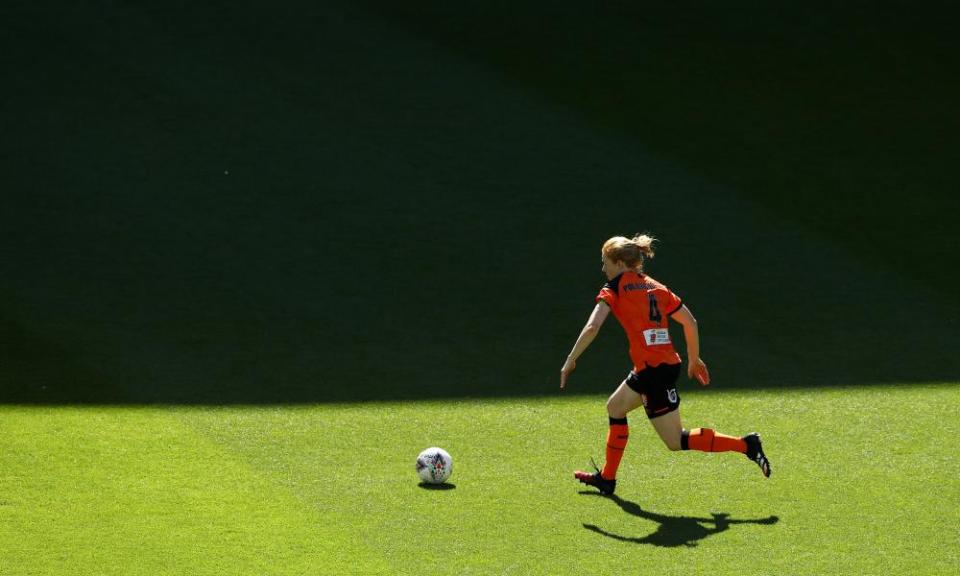Milestone women a monument to W-League’s enduring persistence

Clare Polkinghorne has been here before. The afternoon sun in Canberra is warm and bright, the crowd is vocal and unforgiving, and Michelle Heyman is tearing away from her towards goal.
Polkinghorne flashes a desperate look towards the sideline official, whose flag has stayed down. The offside trap that she and her Brisbane Roar teammates had set to keep Heyman contained has been breached. The Roar captain watches forlornly as the Canberra United striker shoulders off her challenger, takes a touch and slots the ball low and hard across the goalkeeper.
Another goal and an assist followed that day for Heyman, as she helped Canberra win the 2011-12 W-League grand final against Brisbane. The game would book-end the most impressive season to date for the iconic forward and the club she became the face of: Heyman would win the Golden Boot while Canberra would become the first club to go through a W-League season undefeated.
Related: 'It’s a constant fight': Four top players discuss the future of women's football
Polkinghorne knew the feeling, though. She was there when Queensland Roar won the double in the league’s inaugural season, defeating Canberra in the championship final. She was there when the Matildas became the first Australian team to win the Asian Cup in 2010. And she was there to become the first defender to win the Julie Dolan medal twice – once in 2013 and again in 2018.
Not much has changed in the almost 10 years since Polkinghorne threw up a hopeless, pale arm as Heyman strode away from her that afternoon in 2012. This past Sunday, the Roar captain watched on as her decade-long W-League rival and Matildas teammate did it again, muscling her opponent off the ball and sliding it past the goalkeeper. That moment – the run, the touch, the finish – was a kind of historical echo, containing within it all the resistance and persistence of not just the two iconic women of Heyman and Polkinghorne themselves, but also the league and the teams they have become synonymous with.
Now in their early 30s, both players celebrated characteristic milestones in the same game at the weekend: Heyman equalled the W-League’s all-time goal scoring record (70, along with Sam Kerr), while Polkinghorne became the first player in league history to tally 150 appearances for the same club (Heyman, for her part, currently sits at 98 appearances for Canberra).
These numbers are all the more impressive when you consider the footballing context within which both have worked for the past decade. Up until the W-League’s collective bargaining agreement in 2017, players in Australia’s top women’s league (including Matildas) did not have guaranteed salaries, nor did they have minimum medical or travel standards. Some players earned $600 a season, some earned nothing at all.

Heyman and Polkinghorne entered the W-League when it was still an amateur competition, working and studying alongside training and playing at the highest domestic level. Their involvement with the national team allowed them to participate in the 2015 strike that put the off-field treatment and support for Australia’s top women footballers in the spotlight; a moment of collective empowerment that snowballed in the following years, resulting in higher standards across the women’s game and arguably contributing to the 2023 Women’s World Cup co-hosting rights.
Heyman’s return to Canberra this season after almost retiring from the game in 2019 is particularly illustrative of the irrepressible determination of a generation of women footballers upon whose shoulders the W-League and the national team now stands.
And yet, despite what has been achieved in recent years, the fact that the league’s veterans – Heyman, Polkinghorne, Teresa Polias, Gema Simon, Tameka Yallop, Leena Khamis, Ellie Brush, Tara Andrews, Caitlin Cooper – must still hold down full-time jobs is a stark reminder of how much work remains to be done to ensure their sacrifices are not in vain.
Related: Cricket Australia vows to address gender imbalance in statues
These are women, like many women throughout history, who have had to work twice as hard for half as much recognition and reward as their male counterparts, simply because they are women. These are women who have been derided and dismissed for pursuing their dreams, who have had to carry the extra weight of not just existing in a male-dominated industry, but thriving there, too.
Monday marked the start of Female Football Week, in line with International Women’s Day and Women’s History Month, and the passion and perseverance of women athletes like Heyman and Polkinghorne ought to be celebrated in ways that extend beyond symbolic breakfasts and social media hashtags.
Their very careers – the fact that they are still here at all – act as their own kind of cenotaph to the individual and collective tenacity that has got the women’s game to where it is today. It is imperative now that their efforts are cemented in and remembered by genuine structural changes that will provide the next generation of Heymans and Polkinghornes with the opportunities that their foremothers had to struggle and scrap for. That, perhaps more than the record number of goals scored or games played, ought to be their lasting legacy; a monument that can last as long, if not longer, than they have.

 Yahoo Sport
Yahoo Sport 




































